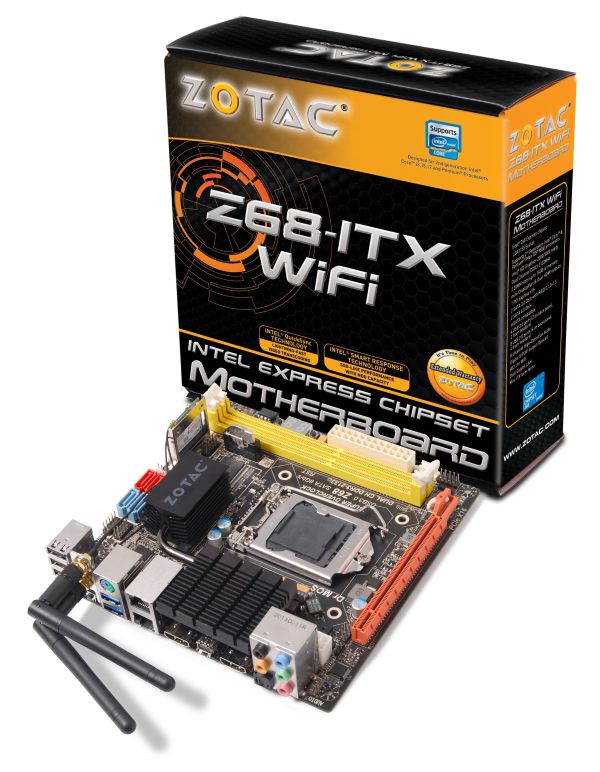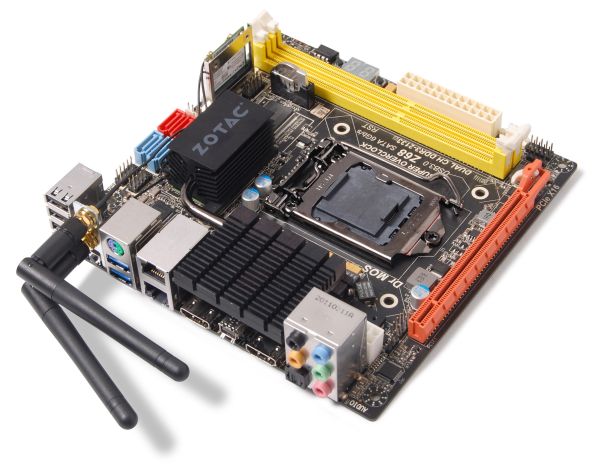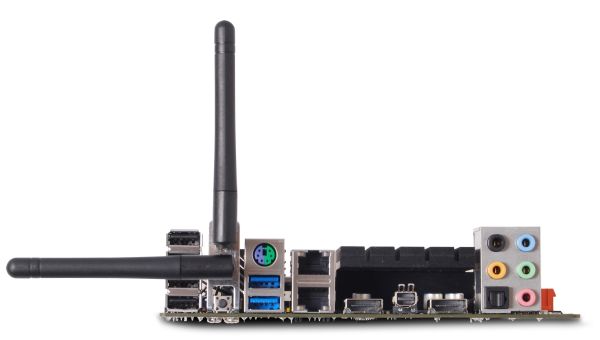Zotac Z68ITX-A-E Wifi Review - Mini-ITX meets Z68
by Ian Cutress on September 22, 2011 10:01 AM EST- Posted in
- Motherboards
- Mini ITX
- ZOTAC
- Z68
With every chipset, there's a call to arms in providing the package that everyone needs. Unfortunately there's never one motherboard which can cater for every possibility, but there are some that come quite close. Our review today is on the Zotac Z68ITX-A-E Wifi - a mini-ITX take on the Z68 chipset, which promises to be a winner right from the start, with dual gigabit Ethernet, USB 3.0, onboard wifi, onboard power/reset buttons, a debug LED, a lot of extras with your motherboard, and all the extras that Z68 offers. For $170, we're looking at a good contender for an award here, as long as the performance and additions compare well to its rivals.
Overview
The most noticeable thing about using the Zotac board for this review is the out-of-spec features used by Zotac. With regards to the turbo of the CPU, the CPU should scale down the multiplier bins the more cores being used - however, the Zotac board likes to apply a 4x multiplier increase, even in full CPU usage. This gives it a distinct advantage in all our stock benchmark suite, and an unfair advantage against every other board in the market. It gives the consumer, however, extra performance without having to do anything. This may set an unhealthy trend, where other manufacturers will similarly produce products out-of-spec in order to jump ahead in performance.
Overall, for $170, Zotac have provided a board full of features that provide a great motherboard for various consumer levels. The addition of dual gigabit Ethernet, onboard wifi, dual HDMI, and that out-of-spec CPU speed are nice additions to such a small product. This situation benefits a non-K Sandy Bridge CPU (which unfortunately negates one of the Z68 features, overclocking, which as we find out isn't that great on the Zotac) where the iGPU is required as well as the PCIe x16 slot. There's not too many SATA ports (two SATA 6 Gbps, two SATA 3 Gbps), which perhaps is ideal for the non-enthusiast consumer (SSD, HDD, DVD/BluRay drive). Also, the lack of overclocking may be a sticking issue for some. I'm unsure if I should label it a gamers' board, a 24/7 machine with various enthusiast applications that require performance, or a multi-monitor setup that needs Sandy Bridge and Z68 and perhaps a GPU for GPU programming. Nevertheless, I've found the board an impressive product at a great price, despite the old fashioned BIOS and lack of software provided.
Visual Inspection
With Zotac's aim of piling as much as it can onto such a small PCB, it is obvious to see that the board is fairly cramped, in a livery with no defined color (yellow, orange, red, blue, black). As a result, the 8-pin 12V CPU power connector is on the far end of the board behind the audio headers of the I/O panel. The CPU socket is also quite small in comparison to full size P67/Z68 boards we've seen this year, negating large CPU coolers but still providing enough space for stock coolers and all-in-one CPU coolers such as the Corsair H50 and H100.
There are two fan headers on board - one by the SATA ports and the other beside the 24-pin ATX power connector. Beside this power connector are the power/reset buttons and a debug LED - it's great to have this on such a small board. The wifi module is in a mini-PCIe (with mSATA compatibility) between the memory slots and the SATA ports - with cables from the wifi card to the I/O panel. A full size mSATA holder is included in the bundle, if the user decides not to use the wifi and takes advantage of the Z68 Smart Caching Technology via this port.
On board are four SATA ports - two SATA 6 Gbps and two SATA 3 Gbps, all from the PCH. Technically the PCH should be able to support two more, but given the size of the board and all the other extras on it, it's understandable that these are not included. Beside the SATA ports are two USB 2.0 headers, and beside them, behind the wifi antenna, is a USB 3.0 header.
The back panel of the board is also similarly cramped, with a combination of wifi antenna, dual gigabit Ethernet, two USB 3.0, four USB 2.0, a clear CMOS button, a PS/2 Connector, dual HDMI and mini-DisplayPort, optical SPDIF output, and the standard audio jacks. The combination of having the heatsink there results in some space lost - perhaps if it wasn't there by design, the HDMI and mini-DP could be stacked and other features could be added.




















29 Comments
View All Comments
DaveSimmons - Thursday, September 22, 2011 - link
SilentPCReview has covered the Silverstone and Lian-li cases for gaming builds, and CyberPowerPC will build you a SG07 system with a GTX 570 if you want one.But yes, some SFF gaming build tests from AT would be welcome as well.
My gaming system is usually just a single card and 2 x HDDs (or SSD + HDD for my next build) so most of even a micro-ATX case sits there empty taking up space.
TrackSmart - Sunday, September 25, 2011 - link
Thanks for the heads up about the articles. I'll check them out.LeftSide - Thursday, September 22, 2011 - link
Is there any way we could get some power numbers on a power supply that more closely resembles the power load these small HTPC motherboards will be using. I don't understand why you can't review these smaller boards with a good 80% 300 watt PS. Most of the people interested in these boards are interested in HTPC usage and idle load is the most important number. Your power numbers are typically useless, because of the low efficiency a 1000 watt PS will run a 50 watt load.The reviews on Anandtech are generally great and very informative, but I don't understand why you even test power consumption when the results are so skewed.
TrackSmart - Thursday, September 22, 2011 - link
As a fellow reader of these reviews, I understand that you can't have any consistency in the results unless you test under the same conditions every time. And that means having a powersupply that can handle any build.That being said, I agree that some tests with small form factor appropriate hardware would be of interest to folks... Not good for comparing performance differences between boards, but to see what you can do with a real build in terms of performance vs noise , heat, and actual power usage. Maybe they'll do an updated small form factor article. Their last guide was based around low power stuff (look it up), but a higher performance update to that guide would be cool.
IlllI - Friday, September 23, 2011 - link
this board got abysmal feedback over on hardforum.some guy had 19 of them die (1+18 replacements if i recall). his company decided to ditch the entire brand due to reliability.
moolman - Friday, September 23, 2011 - link
I didn't try this board but I tried two of the H67 boards. Both boards had defective displayports, they wouldn't work, everything else worked fine. Just beware, I posted and called Zotac for help and it seems they know of the problem but who uses display ports for integrated graphics, so I was probably the only guy complaining about it. But I have a 30" monitor so no choice in the matter. Luckily I bought from Fry's and hence able to try out 2 boards. Ended up with the Intel H56 ITX, glad I did, quieter and uses less energy. Thanks Zotac for sucking.lwatcdr - Friday, September 23, 2011 - link
I could see this as a one box server solution for a small business.Two nics so configure this as a fire wall.
WiFi= Wifi access point for the office "If it supports it."
Two SATA 6 ports Two big drives in a RAID.
Two SATA 3 ports boot drive/swap/
MSATA cache.
Install Asterisk for your phone system, vTiger CRM, an email server, what ever else you want or need.
USB ports Backup drives, printers, scanners.
You have the makings of an all in one small business server.
Shadowmaster625 - Friday, September 23, 2011 - link
Does that thing even have a specified efficiency at 50 watts? I dont think the 80 plus applies unless you are at 10% load.waldojim42 - Friday, September 23, 2011 - link
I see no reason to drop in a new bios just to compete with other manufacturers. If the others want to compete with Zotac, add in the "out of spec" options for people! I find it odd that it was more "fair" for you guys to kill off one channel of ram, than leave the thing to its higher clock rates.I am more interested in how well it handled running 4x over on all cores using stock cooling, than running a crippled machine.